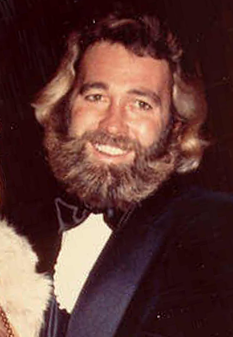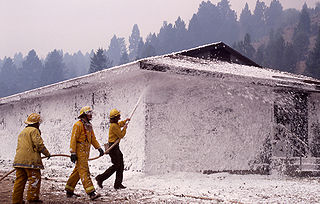Related Research Articles

The Kuwaiti oil fires were caused by the Iraqi military setting fire to a reported 605 to 732 oil wells along with an unspecified number of oil filled low-lying areas, such as oil lakes and fire trenches, as part of a scorched earth policy while retreating from Kuwait in 1991 due to the advances of US-led coalition forces in the Gulf War. The fires were started in January and February 1991, and the first oil well fires were extinguished in early April 1991, with the last well capped on November 6, 1991.

In Old Chicago is a 1938 American disaster musical drama film directed by Henry King. The screenplay by Sonya Levien and Lamar Trotti was based on the Niven Busch story, "We the O'Learys". The film is a fictionalized account about the Great Chicago Fire of 1871 and stars Alice Brady as Mrs. O'Leary, the owner of the cow which started the fire, and Tyrone Power and Don Ameche as her sons. It also stars Alice Faye and Andy Devine. At the time of its release, it was one of the most expensive movies ever made.

Daniel Francis Haggerty was an American actor who was best known for playing the title role in the film and television series The Life and Times of Grizzly Adams.

A conflagration is a large fire. Conflagrations often damage human life, animal life, health, and/or property. A conflagration can begin accidentally or be intentionally created (arson). A very large fire can produce a firestorm, in which the central column of rising heated air induces strong inward winds, which supply oxygen to the fire. Conflagrations can cause casualties including deaths or injuries from burns, trauma due to collapse of structures and attempts to escape, and smoke inhalation.

Paul Neal "Red" Adair was an American oil well firefighter. He became notable internationally as an innovator in the highly specialized and hazardous profession of extinguishing and capping oil well blowouts, both land-based and offshore.

Erle Palmer Halliburton was an American businessman specializing in oil field services.

Aerial firefighting also known as Waterbombing is the use of aircraft and other aerial resources to combat wildfires. The types of aircraft used include fixed-wing aircraft and helicopters. Smokejumpers and rappellers are also classified as aerial firefighters, delivered to the fire by parachute from a variety of fixed-wing aircraft, or rappelling from helicopters. Chemicals used to fight fires may include water, water enhancers such as foams and gels, and specially formulated fire retardants such as Phos-Chek.

Hellfighters is a 1968 American adventure film directed by Andrew V. McLaglen and starring John Wayne, Katharine Ross and Jim Hutton. The movie depicts a group of oil well firefighters and is based loosely on the life of Red Adair. Adair, "Boots" Hansen, and "Coots" Matthews served as technical advisers on the film.
Superior Oil Company was an American oil company founded in 1921 in Coalinga, California, by William Myron Keck, Superior Oil began as a drilling contracting firm and grew into the exploration and production of oil and natural gas. In 1930 the company was the first to successfully use directional drilling in California. Moving to Houston, Texas.
Walter Benona Sharp was an American oilman and innovator in drilling techniques.

Firefighting foam is a foam used for fire suppression. Its role is to cool the fire and to coat the fuel, preventing its contact with oxygen, thus achieving suppression of the combustion. Firefighting foam was invented by the Russian engineer and chemist Aleksandr Loran in 1902.

A blowout is the uncontrolled release of crude oil and/or natural gas from an oil well or gas well after pressure control systems have failed. Modern wells have blowout preventers intended to prevent such an occurrence. An accidental spark during a blowout can lead to a catastrophic oil or gas fire.

Bunker gear is the personal protective equipment (PPE) used by firefighters. The terms are derived from the fact that the trousers and boots are traditionally kept by the firefighter's bunk at the fire station to be readily available for use.
As firefighting has a rich history throughout the world, traditions in this profession vary widely from country to country.

Oil well fires are oil or gas wells that have caught on fire and burn. They can be the result of accidents, arson, or natural events, such as lightning. They can exist on a small scale, such as an oil field spill catching fire, or on a huge scale, as in geyser-like jets of flames from ignited high pressure wells. A frequent cause of a well fire is a high-pressure blowout during drilling operations.
"Fire at Rig 15" is the 19th episode of Captain Scarlet and the Mysterons, a British Supermarionation television series created by Gerry and Sylvia Anderson. Written by Bryan Cooper and directed by Ken Turner, it was first broadcast on 16 February 1968 on ATV Midlands.
Boots & Coots was a well control company. It was founded in 1978 by Asger "Boots" Hansen and Ed "Coots" Matthews, veterans of the Red Adair Service and Marine Company. The two companies extinguished approximately one third of the more than 700 oil well fires set in Kuwait by retreating Iraqi soldiers in the Gulf War. This work was featured in the 1992 film Lessons of Darkness.
The Devil's Cigarette Lighter was a natural gas well fire at Gassi Touil in the Sahara Desert of Algeria. Ignited by static electricity when a pipe at the GT2 well ruptured on November 6, 1961, the Phillips Petroleum Company/OMNIREX/COPEFA-owned well produced more than 6,000 cubic feet (170 m3) of natural gas per second, whose flame rose between 450 feet (140 m) and 800 feet (240 m). The flame was seen from orbit by John Glenn during the flight of Friendship 7 on February 20, 1962. The blowout and fire were estimated to have consumed enough gas to supply Paris for three months, burning 550,000,000 cubic feet (16,000,000 m3) per day.
Volodymyr Pavlovych Pravyk was a Soviet firefighter notable for his role in directing initial efforts to extinguish fires following the Chernobyl Disaster. Following the event, he was hospitalized with acute radiation syndrome and died sixteen days later. He was posthumously awarded the Hero of the Soviet Union and the Order of Lenin by the Soviet Union, and later the Ukrainian Star For Courage in recognition of his efforts.
References
- Chickasha Area Arts Council Brief funerary bio sketch of Kinley and his wife.
- The Fire Beater, a 1953 article from Time magazine.